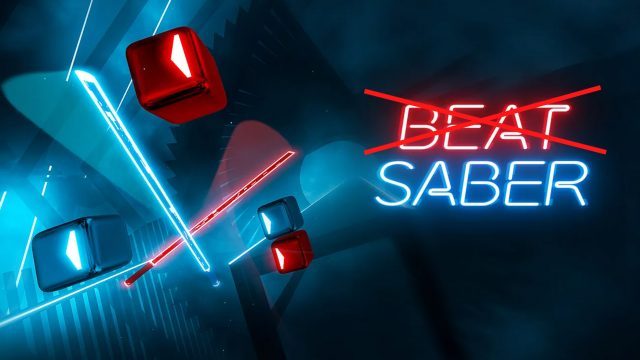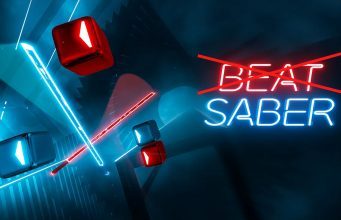

Our series Inside XR Design highlights and unpacks examples of great XR design. Today we’re looking at Beat Saber (2019) and why its most essential design element can be used to make great VR games that have nothing to do with music or rhythm.
You can find the complete video below, or continue reading for an adapted text version.
More Than Music
Welcome back to another episode of Inside XR Design. Now listen, I’m going to say something that doesn’t seem to make any sense at all. But by the end of this article, I guarantee you’ll understand exactly what I’m talking about.
Beat Saber… is not a rhythm game.
Now just wait a second before you call me insane.
Beat Saber has music, and it has rhythm, yes. But the defining characteristic of a rhythm game is not just music, but also a scoring system that’s based on timing. The better your timing, the higher your score.
Now here’s the part most people don’t actually realize. Beat Saber doesn’t have any timing component to its scoring system.
That’s right. You could reach forward and chop a block right as it comes into range. Or you could hit it at the last second before it goes completely behind you, and in both cases you could earn the same number of points.
So if Beat Saber scoring isn’t about timing, then how does it work? The scoring system is actually based on motion. In fact, it’s actually designed to make you move in specific ways if you want the highest score.
The key scoring factors are how broad your swing is and how even your cut is through the center of the block. So Beat Saber throws these cubes at you and challenges you to swing broadly and precisely.
And while Beat Saber has music that certain helps you know when to move, more than a rhythm game… it’s a motion game.
Specifically, Beat Saber is built around a VR design concept that I like to call ‘Instructed Motion’, which is when a game asks you to move your body in specific ways.
And I’m going to make the case that Instructed Motion is a design concept that can be completely separated from games with music. That is to say: the thing that makes Beat Saber so fun can be used to design great VR games that have nothing to do with music or rhythm.
Instructed Motion
Ok so to understand how you can use Instructed Motion in a game that’s not music-based let’s take a look at Until You Fall (2020) from developer Schell Games. This is not remotely a rhythm game—although it has an awesome soundtrack—but it uses the same Instruction Motion concept that makes Beat Saber so much fun.
While many VR combat games use physics-based systems that allow players to approach combat with arbitrary motions, Until You Fall is built from the ground up with a notion of how it wants players to move.
And before you say that physics-based VR combat is objectively the better choice in all cases, I want you to consider what Beat Saber would be like if players could cut blocks in any direction they wanted at all times.
Sure, you would still be cutting blocks to music, and yet, it would be significantly harder to find the fun and flow that makes the game feel so great. Beat Saber uses intentional patterns that cause players to move in ways that are fluid and enjoyable. Without the arrows, player movements would be chaotic and they’d be flailing randomly.
So just like Beat Saber benefits by guiding a player to make motions that are particularly satisfying, combat in VR can benefit too. In the case of Until You Fall, the game uses Instructed Motion not only to make players move a certain way, but also to make them feel a certain way.
When it comes to blocking, players feel vulnerable because they are forced into a defensive position. Unlike a physics-based combat game where you can always decide when to hit back, enemies in Until You Fall have specific attack phases, and the player must block while it happens, otherwise you risk taking a hit and losing one of just three hit points.
Thanks to this approach, the game can adjust the intensity the player feels by varying the number, position, and speed of blocks that must be made. Weak enemies might hit slowly and without much variation in their attacks. While strong enemies will send a flurry of attacks that make the player really feel like they’re under pressure.
This gives the developer very precise control over the intensity, challenge, and feeling of each encounter. And it’s that control that makes Instructed Motion such a useful tool.
Dodging is similar to blocking, but instead of raising your weapon to the indicated position, you need to move your whole body out of the way. And this feels completely different from just blocking.
While some VR combat games would let the player ‘dodge’ just by moving their thumbstick to slide out of the way, Until You Fall uses Instructed Motion to make the act of dodging much more physically engaging.
And when it comes to attacking, players can squeeze in hits wherever they can until an enemy’s shield is broken, which then opens an opportunity to deal a bunch of damage.
And while another VR game might have just left this opening for players to hit the enemy as many times as they can, Until You Fall uses Instruced Motion to ask players to swing in specific ways.
Swinging in wide arcs and along particular angles deals the most damage and makes you move in a way that feels really powerful and confident. It’s like the opposite feeling of when you’re under attack. It really feels great when you land all the combo hits.
Continue on Page 2: Motion = Emotion
The post The Secret to ‘Beat Saber’s’ Fun Isn’t What You Think – Inside XR Design appeared first on Road to VR.
from Road to VR https://ift.tt/uYETv61
via IFTTT
No comments:
Post a Comment